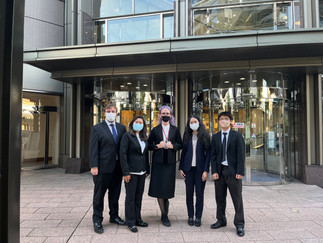2022年9月One Month Update
- Aimee Miessler
- Oct 2, 2022
- 5 min read
Updated: Oct 9, 2022

Hello!
What a month it has been! I officially finished my first month as an ALT this past week, I`ve been finding lots of differences between American and Japanese elementary and junior high (middle) schools that I`d love to share with you. Routines and rituals are important in Japanese culture and it heavily influences the routines of school schedules.
Cleanliness is very important in Japanese culture. I was curious as to why this was so I read some literature on the topic. To make a 2000+ year story short, much of the cleanliness belief stems from the emphasis of cleanliness in Shintoism, which is a religion originated in Japan that emphasizes the importance of respect. They respect their elders and things and everything around them. They believe there are spirit gods, or かみ (kami), in everything around us from the plants and animals to inanimate object like books, kitchenware, and even toilets! It is believed that if you neglect to take care of things around you, the kami will become angry and go on a rampage (oh no, not the toilet kami)! The same goes for self-cleanliness. You are a part of nature too, so you need to keep up appearances. Cleanliness is not considered a bothersome chore, but a ritual to look forward to and have fun with.
So, now that we know the (very brief) origin of Japanese cleanliness culture, I will dive into how this is translated into everyday school routines. Many schools have a janitor, but most of the school cleaning falls on the students. There are designated times during the day (usually after lunch) blocked out so students can clean the school with the help of teachers and staff. Students clean their classrooms, hallways, and cafeterias. Students are also responsible for making their school lunch and cleaning up afterwards. Before lunch, students wash their hands; after lunch, they brush their teeth! Before they start their next class, they have cleaning time in which they clean the school grounds.
Aside from cleanliness routines, students complete an あいさつ (aisatsu), which is a greeting before each class period. For example, before we start and after we finish English class, one student says Stand up! Let`s start/finish English! (the rest of the class repeats this), then they bow.

People in Japan tend to worry about how others view them. They are conscious about everything from keeping their work desk tidy to their posture. This is a picture of a reminder posted in the 3rd year class of one of my elementary schools.

Another regular practice is to say good morning and goodbye to your teachers. Schools in Japan have a teacher/staff desk room where students can come in with any questions, comments, concerns they have. Some students quietly greet us while other students practically yell their greetings. Every day, a student comes into the teachers room to ask their teachers what the next day`s lessons will be for a particular subject. Whenever there is an announcement on the PA, students stop walking and talking to listen.
As for the students, they are, as all children are, so cute! I wish I can show you pictures of the students, but Japan has very strict privacy laws in place for children. Some of my students are pretty good at English and I want to encourage the rest to enjoy English! 3rd and 4th year elementary school students do not get graded in English, so most students actively participate during class and we have a lot of laughs! Once they go into 5th and 6th year, elementary school students, English is graded, but it is simple enough to still have fun.

One of my 5th year students always comes up to me after class and talks about her favorite manga/anime, Jojo`s Bizzare Adventure. On Wednesday, she gave me drawings of her favorite characters from the 5th season of Jojo`s. She likes to practice her English by talking about things she likes.
During a student`s junior high school years, they become more challenged in their academics, so English may not be as much fun for them as it was in elementary school. My main goal in every class is to make each student smile or laugh, whether I do a funny gesture or say something completely incorrect in Japanese (I once called a game we played butt and my students went crazy). Junior high school 3rd years tend to be stressed about high school entrance exams. Unlike in other countries, mandatory schooling ends in junior high school and all high schools require an entrance exam to be accepted. About 98% of students go forward to high school, but they can also go to vocational school or even immediately start in the workforce.
School lunches are provided to students and teachers in elementary and junior high school. It is amazing how healthy and delicious these lunches are! Students make the lunch and serve it to the other students and teachers. I believe there is a member of the staff that cleans the used dishes and utensils in order to protect the students from any possibility of catching any illnesses. Here are just a few pictures of what I had for lunch at school:
On a Personal Note ~
With the stresses of moving to a new apartment in a new town in a new country, I sure have a lot of stress I need to manage. Thankfully, many of my co-workers at my schools have been more than kind in introducing me to Noto and the surrounding areas and helping me become a part of the town. One of the support staff at one of my elementary schools lives across the street from my apartment complex, has brought me soba (buckwheat noodles), shijimi clams from her friend in Shimane prefecture, and various sweet treats, and has become my school mom.
Another coworker drove me around the Noto Peninsula, took me to cute cafes and eateries, and showed me the ゴジラ岩 (Gojiraiwa: Gojira is Godzilla, iwa is Rock), 窓岩 (Madoiwa: Mado is window), 白米千枚田 (Senmaida Rice Terraces), and many famous salt farms along the Sosogi coast of the peninsula. Noto is considered rural and with that comes minimal light pollution. Growing up in South Florida, I was never able to step outside of my place and see endless stars lighting up the night sky. I have seen 4 shooting stars and many more constellations than I`ve ever seen before!
I`ve also gotten to hang out with my fellow ALT`s in the Deep Noto area! The Deep Noto includes four towns located in the peninsula: Noto, Suzu, Wajima, and Anamizu. We went to Kanazawa, the capital of Ishikawa Prefecture, and went shopping, went to a karaoke lounge, ate ramen and paella, played crane games at Taito Game Station, listened to various Jazz festival performances around the city and marched in the 2nd annual Kanazawa Pride Parade! I feel very grateful to be a part of this wonderful, diverse group of ALT`s from the United States, Canada/El Salvador, Ireland, and South Africa and can`t wait to share more fun experiences I have with them!
As always, thank you so much for taking the time to read about my experiences! If you have any questions or comments, please write them below. With that, I`ll see you in the next post!
ゆり
Resources about Cleanliness
Sosogi Coast:
Senmaida Rice Terraces
Shijimi Clams



























Well done Aimee! Thanks for sharing your experiences! 💖